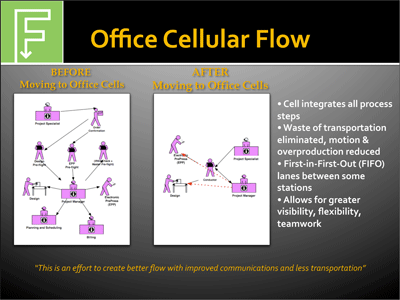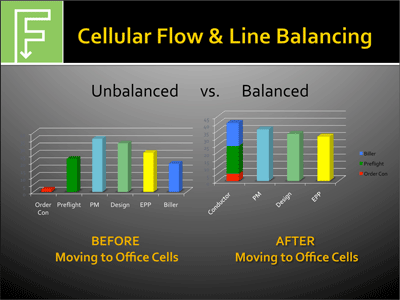ONLINE EXCLUSIVE: Disc Makers: Visual Management in a Cellular Office
Lea A.P. Tonkin, editor in chief
 Making the transition from traditional office processes to cellular operations supported by visual management is a work in progress for Pennsauken, NJ-based Disc Makers. The privately held company’s continually shifting customer base and range of services compound the challenges of change. Disc Makers offers everything from CD and disc replication/duplication to custom USB flash drives, CD and DVD design services, posters and postcards, download cards, blank media and supplies, mastering services, and CD/DVD templates. The company has approximately 350 employees.
Making the transition from traditional office processes to cellular operations supported by visual management is a work in progress for Pennsauken, NJ-based Disc Makers. The privately held company’s continually shifting customer base and range of services compound the challenges of change. Disc Makers offers everything from CD and disc replication/duplication to custom USB flash drives, CD and DVD design services, posters and postcards, download cards, blank media and supplies, mastering services, and CD/DVD templates. The company has approximately 350 employees.
“We’ve been working on lean since February 2009,” said Gerard Caruso, lean and continuous improvement (CI) specialist. He will be a presenter at the AME 2011 Dallas conference. “Sometimes you go two steps forward and one step back,” Caruso said. “We started with lean in production, and now we also have lean office cells. In the office, we ran a pilot for almost 18 months, recently moving almost everyone in the office to work in the new system. It has been a challenge.”
Reducing Leadtimes, Travel Distances
Disc Makers launched its office lean transition to get materials ready for production more quickly and accurately, Caruso explained. The average leadtime is six days (at 110 jobs a day, 660 jobs are in its pre-manufacturing process). Travel distances for associates gathering and checking these jobs average a half mile.
“This distance forced us into batching in order to be efficient,” Caruso said. “From value stream mapping, we learned that we had complete, accurate information across the process 9 percent of the time,” he added. “To improve communications and accuracy while reducing travel distances and leadtimes, a cross-functional team including management, plus core and team leads, developed a current-state analysis. The team leads improvement discussions and documents how we are performing.”
New Roles, Challenges
“In our pre-approval and post-approval climate, we get material supplied for a client, then go ahead and do content for independent artists and musicians — DVDs, CDs, print and publishing services, providing duplication machines and other hardware, etc.,” Caruso said. “We’re set up to receive two types of work — design-supplied, or we’ll create the design for the client. For example, we receive content like music or a film from a member of the band or a director, and we’ll design, create, and package for them. Our turnover for new clients is constant — a band breaks up, etc.
“Another challenge is that we combined various roles into new roles,” Caruso said. “For example, we combined work by billers with pre-flight graphics — people who check files and perform other pre-production tasks.” Project manager and graphics specialist jobs remained relatively the same.
 Taking a Step Back to Move Ahead
Taking a Step Back to Move Ahead
“We’ve come to realize that we need some building blocks to make it work,” Caruso said. “With our visual management board, we need to identify what is in each one of the cells and to identify standard work. We need to write this down so we can identify top performance, eliminate variation, and deal with balance issues in each cell.
“We needed to take a step back — asking participants in each cell about their work,” said Caruso. “For example, for conductors (these associates do billing, order confirmation including payment receipt and sometimes artwork receipt, and pre-flight tasks), how long does it take to book a job or pre-flight a job? We are communicating these findings across the board. We want similar results from each cell.
“We have different kinds of cells. There are two design cells — the client tells us their ideas and we create material. In other cells, we get content from seasoned designers and novices alike,” Caruso said. “We’ve experimented with other cells that included design and electronic prepress. And one cell is for reorders, and for those requiring special attention or a second language.”
In pre-flight work, needed support files (often with various images and fonts) are assembled and checked so the job can move to pre-press operators. If the job is design-supplied, it will always go to a pre-press operator.
“In our design cells, there is still a type of ‘pre-flight;’ it is different than if the job is design-supplied,” Caruso said. “As jobs are booked in, we can make disposition on which cell it should travel to, based on how it was sold. Pre-flight is vital to not draining capacity from our operators.”
Results and Plans
“Since we moved into cells, the amount of time from when a job is booked to the time when the client sees the first proofs decreased to 12 feet,” Caruso said. “Complete and accurate results are improving. It’s more likely that correct information goes to the next person down the line. We are seeing some factors moving in the right direction. We have reduced leadtime 50 percent, and we are decreasing queues and sorting activities. On-time performance was 74 percent before we moved to the cellular work flows. Now we are 95 percent on time.”
Caruso said associates continue to sort out communications and other issues. “We started with communications boards, listing our problems and issues,” he said. “We need to agree on the problem first, and then work on the solution, not the other way around.
“A challenge is that designers and others are no longer centrally located in departments, where they can bounce ideas off each other. So in our cellular operation, we need to keep our design, pre-press application, and other skills up to date,” he said.
“We’re still relatively early in our journey. We will continue to stabilize and then combine standards from all our work cells on factors such as order fulfillment,” Caruso said. “People need to know how they are contributing to the overall success of the company — how they are contributing to ‘true north.’”


